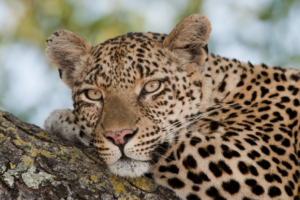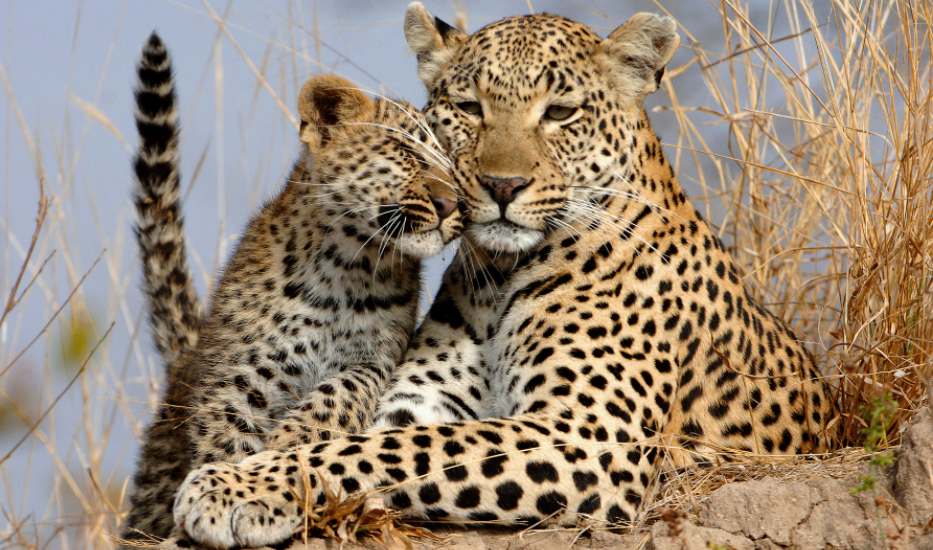African Leopards (Panthera pardus)
African Leopards (Panthera pardus) : are one of the most feared but respected animals in the world. In Uganda; it is called Ngo (Luganda tribe) also one of the 52 totems of Buganda, Eris (Iteso tribe) and Engwe (Bakonjo tribe). Leopards are generally big cats known for their golden, spotted bodies and graceful, yet ferocious hunting techniques. In most parts of Africa, there is a belief that leopards sometimes represent the super natural powers. In fact, most African kings have the leopard skin as part of their seats and the logic is that they share in the invincibility of the giant cat.
 There is also a belief that sometimes leopards represent a spirit (Musambwa). Therefore, whenever a leopard is sighted in an area, people are advised to be careful before attacking it. Besides, some of the leopards might be spirits, a traditional healer for example salongo ssentongo in Luwero. Uganda cautions that such leopards neither attack humans nor domestic animals and instead they are harmless. As a matter of fact, in some parts of Luwero village, there are leopards that are known by the villagers.
There is also a belief that sometimes leopards represent a spirit (Musambwa). Therefore, whenever a leopard is sighted in an area, people are advised to be careful before attacking it. Besides, some of the leopards might be spirits, a traditional healer for example salongo ssentongo in Luwero. Uganda cautions that such leopards neither attack humans nor domestic animals and instead they are harmless. As a matter of fact, in some parts of Luwero village, there are leopards that are known by the villagers.
In Western Uganda, it is common to hear people curse others: “Death at the hands of a leopard”. The Makanga of Central Africa also believes that witch doctors are capable of turning themselves into leopards before hurting their enemies.
Interesting facts about Leopards
- Leopards are the most successful and cunning among big cats.
- The Clouded Leopard has the longest canines amongst cat species.
- Pound for pound, leopards are the strongest among big cats.
- Leopards are territorial animals and regularly mark and defend their domain against intruders.
- Leopards don’t need much water. They survive from the moisture they get from eating their prey.
- Man eating leopards always operate at night since unlike tigers they never lose their fear of man and only enter human territories in the cover of darkness – according to famous hunter turned conservationist Jim Corbett. This makes them very difficult to counteract.
Appearance
These animals are masters of stealth and extremely difficult to trace and locate in the wild. They are also light coloured with distinctive dark spots that are called rosettes because they resemble the shape of a rose. However, black leopards, which appear to be almost solid in colour because their spots are hard to distinguish, are commonly called black panthers.
Diet
Leopards are carnivores, however, they aren’t picky eaters. They also prey on any animal that comes across their path. Some of these include; Thomson’s gazelles, cheetah cubs, baboons, rodents, monkeys, snakes, large birds, fish, antelopes, warthogs, etc.
Behavior
The leopard is so strong and comfortable in trees in that it often hauls its kills into the branches. They can also hunt from trees, where their spotted coats allow them to blend with the leaves until they spring with a deadly pounce. These animals are also solitary creatures that only spend time with others when they are mating or raising young. On the other hand, they are nocturnal and spend their nights hunting instead of sleeping.
These nocturnal predators also stalk antelope, deer, and pigs by stealthy movements in the tall grass. When human settlements are present, leopards often attack dogs and occasionally people. They are also strong swimmers and very much at home in the water, where they sometimes eat fish or crabs.
Breeding

Female leopards generally have a gestation period of approximately three months. They typically give birth to a litter of two to three cubs in a den at any time of the year. They usually have two grayish, blind and almost hairless cubs with barely visible spots. Each cub weighs just 17 to 21 ounces (500 to 600 grams) at birth. The mother hides her cubs and moves them from one safe location to the next. In fact, this is done until they are old enough to begin playing and learning to hunt. At 12 to 18 months, the cubs are ready to live on their own although they still live with their mothers for about two years. When they reach 2 or 3 years old the cubs will create their own offspring. More so, leopards live 12 to 15 years in the wild and up to 23 years in zoos.
Habitat
They have a preference for wooded or rocky habitats unlike cheetahs and thus can be found in virtually all habitats that offer adequate cover. African leopards generally inhabited a wide range of habitats within Africa. These include; woodlands, grassland savannas, forests, mountain habitats, coastal scrubs, shrub lands and swampy areas. Leopards are generally most active between sunset and sunrise and kill more prey at this time.
Where to find them
They are present in most Uganda parks and forest reserves but can be seen most regularly in every section in Queen Elizabeth National park on the kisenyi plains in the northern part of the park, they can also be sighted in southern part of the park.








Leave a Reply
Want to join the discussion?Feel free to contribute!